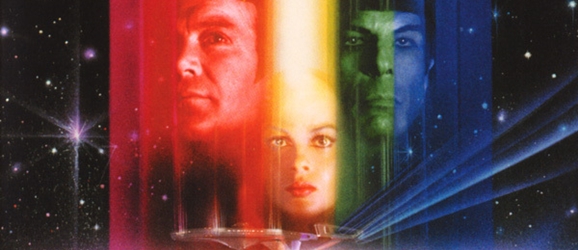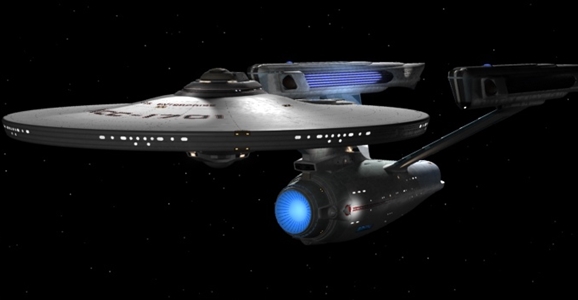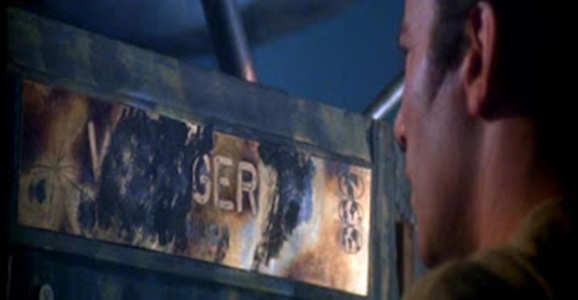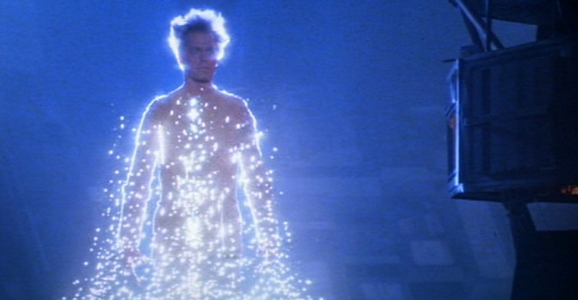Trekking Backwards With Star Trek: The Motion Picture
Spending some quality time with V'Ger.
This article is more than 2 years old
 With Star Trek Into Darkness finally arriving in American theaters next week, I decided to take a trek of my own: namely, by revisiting the first six “classic” Star Trek movies. First up, 1979’s Star Trek: The Motion Picture. While it’s not the easy punchline Star Trek V has become, it has a reputation of being deadly dull and slow. Sitting down to watch it for the first time in at least 15 years, it was almost like going in fresh. How would it hold up? Below, the direct feed from my brain as I rewatched Star Trek: The Motion Picture…
With Star Trek Into Darkness finally arriving in American theaters next week, I decided to take a trek of my own: namely, by revisiting the first six “classic” Star Trek movies. First up, 1979’s Star Trek: The Motion Picture. While it’s not the easy punchline Star Trek V has become, it has a reputation of being deadly dull and slow. Sitting down to watch it for the first time in at least 15 years, it was almost like going in fresh. How would it hold up? Below, the direct feed from my brain as I rewatched Star Trek: The Motion Picture…
As the film opens up, we see an encounter between the mysterious cloud and three unlucky Klingon vessels. This would have been the first time Trek fans were introduced to the newly redesigned Klingons. I was too young to have seen the movie in theaters, so I find myself wondering if the redesign was common knowledge, back before fans had the benefit of internet spoilers. How many moviegoers were left wondering who those bumpy guys were supposed to be? Also: the Klingons are a lot more werewolf-y in this movie than they are later. Glad they toned down the teeth a bit.
Fun fact: Starfleet headquarters has escalators. You don’t see a lot of escalators in science fiction; it’s all turbolifts or pneumatic tubes. This troubles me.
Kirk hitches a ride with Scotty up to the snazzy new Enterprise, and I’m struck by just how gorgeous this movie’s model work is. And you have plenty of time to admire it, because here’s where the movie’s reputation for having “leisurely” pacing comes into play. Director Robert Wise has the camera make passionate love to absolutely every angle of the ship, which is cool at first but soon has you checking your watch because it just goes on and on and on.

I really like the grey-and-white uniform Kirk is sporting early in the film, and I wonder why they didn’t just make that the template for all the Starfleet uniforms here. Instead, everybody on the Enterprise looks like they’re wearing pajamas. During the shuttle ride Scotty looks like he’s working up the courage to invite Kirk to a key party, but that may just be his mustache talking.
The transporter malfunction, where the new Vulcan science officer and navigator get turned inside out, scared the crap out of me as a kid. Now I suspect it was an inside job so Spock could get his old job back without having to fill out any paperwork.
Bones gets a hell of an entrance, and not just because they beam him in and he hates that. He has a mountain-man beard and looks like he just stepped off the set of Saturday Night Fever. Is he wearing an Olympic gold medal around his neck? If Karl Urban sports this get-up at any point during Into Darkness, I promise to forgive J.J. Abrams for the “we beamed Scotty into the plumbing” sequence.

“Oh, you know. Stayin’ alive.”
The Enterprise finally leaves spacedock a half hour into the movie. This in spite of the fact that they keep talking about what a hurry they’re in to rendezvous with the Deadly Space Cloud. They’re in such a hurry, in fact, that they kick it up to warp while still inside the solar system, which is implied to be dangerous. Sure enough, they hit warp and accidentally create a wormhole. Thank God Kirk has those knee braces to keep him in his chair!
Fun fact #2: Going through a wormhole is sort of like going back in time in Star Trek IV, but without the trippy melting faces.
Spock eventually shows up wearing something from the Logan’s Run collection and takes over his recently vacated old job. A little too conveniently vacated, if you ask me.
As the Enterprise reaches the edge of the cloud — an hour into a two-hour-plus movie — V’Ger does the same thing it did with the Klingons, trying to vaporize the Enterprise rather than just saying hello. Here’s the thing, though: V’Ger is huge and has access to unfathomable levels of power, so none of the people it zaps could possibly be a serious threat. They can’t even reach its vulnerable core until the machine lets them in personally. This leads me to conclude that V’Ger is kind of a dick. At least the whale probe from Trek IV made a mess of things as an unintended consequence of its mission. The whale probe had class. V’Ger’s just a jerk.

Once the ship enters the cloud, the complaints about the movie’s pacing become valid again. The whole sequence where the Enterprise is navigating deeper into the cloud is beautiful and trippy, but it grinds the narrative to a standstill. Honestly, a skilled editor could probably get this thing down to an hour and a half without losing anything vital.
I get that the sequence is all about establishing V’Ger’s impossible scale, and giving the audience that sense of wonder that’s important for science fiction tales. But they still could have sped things up a bit. Then again, Peter Jackson is currently making three freaking Hobbit movies, so I think from now on maybe Star Trek: The Motion Picture should get a pass in this regard.
While we’re talking size, it’s said early on that the V’Ger cloud is 82 AUs in diameter (or a mere 2 AU if you’re watching the 2001 director’s cut). That’s ridiculously huge. That’s huge to the point of just being silly. Why is V’Ger so damn big? It makes it seem imposing and mysterious, sure, but V’Ger’s a machine, an orderly and logical being. They hammer that in time and again. Supposedly it has absorbed unbelievable quantities of information during its voyage, and it got retrofitted by a mysterious machine race, but the scale doesn’t seem very efficient, does it? Especially when you consider that storage/computing power generally evolves to require less and less physical space. The room-filling mainframes of a few decades ago now can’t even match the power of our cell phones. If you pulled up the floorboards, is V’Ger just a bunch of Atari tape drives daisy-chained together?
After the glowy V’Ger probe abducts sexy bald navigator Ilia, a duplicate of her is sent back for former-Captain Decker to make goo-goo eyes at. Those stares are at least understandable since the Ilia ‘bot spends the rest of the movie in a bathrobe that puts all five miles of her legs on display. This seems questionable from a narrative standpoint, but I am strangely okay with it. (I won’t even broach the subject of her high heels.)

This isn’t relevant to anything, really, but I love that the Enterprise security guys wear old-timey football helmets and enormous codpieces.
Eventually the Enterprise is parked outside V’Ger’s giant space sphincter, and Spock decides to steal a rocket pack and make his way deeper into V’Ger so he can meld with her. This is not as pornographic as that sentence made it sound, but Spock does try to get handsy with V’Ger. Or rather with a giant version of Ilia that’s basically hanging around in V’Ger’s waiting room for some reason. It’s all a little surreal, but I’m okay with it because it made me think of this.
All kidding aside, I do like the parallels between Spock, a character who struggles with the duality of his human/Vulcan heritage, and V’Ger, a machine who has infinite knowledge but lacks the “human element” to assign meaning or purpose to any of it. There are some nice themes at work here, even if the script and direction don’t always make the best use of them.
Once Kirk and company finally reach the heart of V’Ger, we get the movie’s infamous twist, where V’Ger is revealed to be Voyager 6, a space probe that was lost in the 20th century after falling into a black hole. We see the name V’Ger on the casing of the original probe…until Kirk wipes away some grease to reveal the full name. And this is where I have to pause again. Why does V’Ger refer to itself as V’Ger? Aside from the fact that it makes for a nifty reveal, why doesn’t it call itself Voyager 6 from the get-go?

Are we supposed to believe that V’Ger forgot its name and asked somebody on the machine planet to check its nametag? And the machine planet’s natives were smart enough to upgrade V’Ger to damn near godhood, but it didn’t occur to them to wipe off the mess with a rag? Or are we to assume that Voyager 6’s name has been corrupted within its actual original programming, resulting in the abbreviated version? If that’s the case, it’s a pretty spectacular coincidence that its name is obscured in exactly the same way on its physical form. Either way, somebody should buy V’Ger a shop towel.
So Decker decides to merge with V’Ger/Ilia and go off exploring higher dimensions and having lots of kinky human-on-machine-intelligence boot-knockery. Not so much as a “beg your pardon for those people I killed,” mind you. See what I mean? Total dick.
All in all, Star Trek: The Motion Picture is not the unwatchable mess I vaguely remembered it as, but neither is it very memorable. The fact that it was followed by one of the best science fiction movies of all time does it no favors, but the story also hangs a lot of its weight on the concluding twist. Once you know the game, the film’s flaws are all the more noticeable, simply because it’s hard to be engaged in a mystery you already know the answers to.

Star Trek: The Motion Picture is technically stunning in many ways, and I can only imagine what it was like for fans of The Original Series to see their favorite characters up on screen with a feature-film budget supporting them. It’s just a shame there isn’t more here to lure Trek fans back. It was interesting to rewatch it, but I don’t see myself returning to this voyage again anytime soon.
Check back tomorrow when I’ll Trek Back to Star Trek: The Wrath of Khan!












